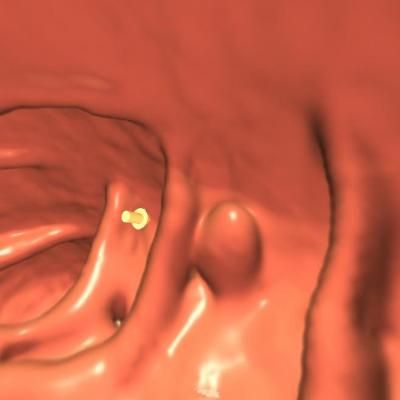Laxative-Free CT Colonography Finds High-Risk Polyps
A no-prep virtual colonoscopy appears to be as effective as a standard colonoscopy in detecting larger polyps that are more likely to become cancers.
A virtual colonoscopy that does not require laxative preparation appears to be as effective as a standard colonoscopy in detecting larger polyps that are more likely to become cancers, according to a study published in the May 15 issue of Annals of Internal Medicine.
The laxative-free procedure employs a new technique that uses computer-aided systems that detect fecal matter and analyzes the acquired images.
To determine the procedure’s effectiveness, researchers from Massachusetts General Hospital in Boston studied 604 patients who underwent the laxative-free protocol, as well as a traditional colonoscopy a few weeks later. CT colonography doesn’t require sedation, but does require a laxative preparation.
The laxative-free protocol involved two days consumption of a low-fiber diet and oral ingestion of small doses of a contrast agent that labels the fecal matter in the colon, before undergoing the CT-scan virtual colonoscopy. Software programs, designed by the researchers, subtracted the labeled feces from the images and analyzed for lesions, primarily adenomas.
The CT colonography results were interpreted by three radiologists who were trained in the use of both the virtual cleansing and the lesion detection systems. They were blinded to the results of the traditional colonoscopies and any diagnosis of tissues that were removed.
The researchers found that the computer-assisted, laxative-free CT colonography had comparable results to that of optical colonoscopy for detecting adenomas of 10 mm or larger. Smaller lesions, which this procedure was not as accurate in detecting, were less likely to show cellular changes associated with a higher risk of developing colon cancer.
The patients completed written surveys, from which it was noted that the laxative-free procedure was more comfortable and easier to prepare for over the traditional procedure. Sixty-two percent of the respondents said it was their preferred screening method.
“If these results hold up in larger trials, we would expect this procedure would be first offered to moderate-risk patients who are otherwise unable or unwilling to be screened,” said Michael Zalis, MD, director of CT Colonography at MGH Imaging and study leader. “If we can validate that this form of CT colonography performs reasonable well for screening and is easier for patients, it could have a significant impact on reducing the incidence of colon cancer and cancer-related deaths.”

This is a CT colonography image, after electronic cleansing, showing an intestinal polyp. The yellow arrow indicating the location of a potential polyp was produced by the computer-aided polyp detection system. Image courtesy Michael Zalis, M.D., Massachusetts General Hospital Imaging.
Study with CT Data Suggests Women with PE Have More Than Triple the One-Year Mortality Rate than Men
April 3rd 2025After a multivariable assessment including age and comorbidities, women with pulmonary embolism (PE) had a 48 percent higher risk of one-year mortality than men with PE, according to a new study involving over 33,000 patients.
The Reading Room: Racial and Ethnic Minorities, Cancer Screenings, and COVID-19
November 3rd 2020In this podcast episode, Dr. Shalom Kalnicki, from Montefiore and Albert Einstein College of Medicine, discusses the disparities minority patients face with cancer screenings and what can be done to increase access during the pandemic.
Predicting Diabetes on CT Scans: What New Research Reveals with Pancreatic Imaging Biomarkers
March 25th 2025Attenuation-based biomarkers on computed tomography (CT) scans demonstrated a 93 percent interclass correlation coefficient (ICC) agreement across three pancreatic segmentation algorithms for predicting diabetes, according to a study involving over 9,700 patients.
Can Photon-Counting CT be an Alternative to MRI for Assessing Liver Fat Fraction?
March 21st 2025Photon-counting CT fat fraction evaluation offered a maximum sensitivity of 81 percent for detecting steatosis and had a 91 percent ICC agreement with MRI proton density fat fraction assessment, according to new prospective research.